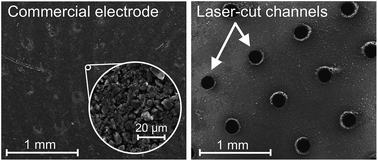Several orders of magnitude increase in the hydraulic permeability of flow-through capacitive deionization electrodes via laser perforations†
Abstract
Capacitive deionization (CDI) is a fast-emerging water desalination technology in which an applied potential of ∼1 V across a pair of porous carbon electrodes removes salt from the feedwater via electrosorption. In flow-through electrode (FTE) CDI cell architecture, feedwater is pumped through the macropores of the porous electrodes, enabling highly compact cells and rapid salt removal. However, FTE CDI requires specialized electrode materials possessing large macropores with diameters above 1 μm in order to allow for reasonable feed pressures. We herein present and demonstrate a low-cost, simple technique for laser perforating CDI electrodes, which delivers highly permeable electrodes from carbon materials with pore structures otherwise unsuitable for flow-through operation. We show that laser cutting channels with ∼200 μm aperture diameters through a commercial CDI electrode material with sub-micron macropores increases the electrode hydraulic permeability by approximately five orders of magnitude, thereby greatly reducing the feed pressure. Furthermore, we demonstrate that key performance metrics such as the cell's salt adsorption capacity and gravimetric capacitance are largely unaffected by the laser perforation technique.



 Please wait while we load your content...
Please wait while we load your content...